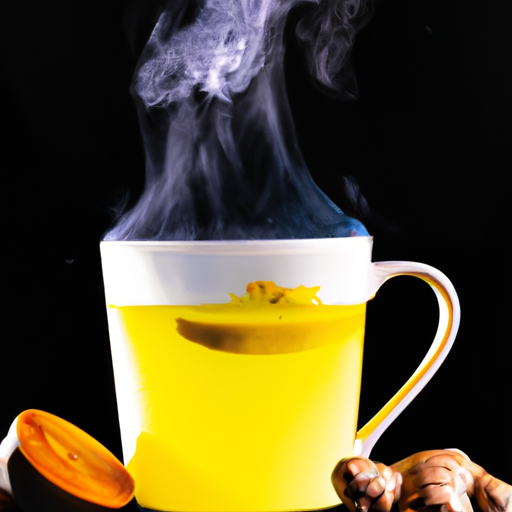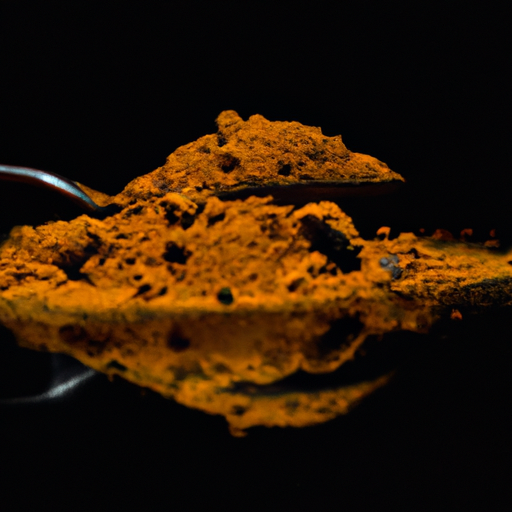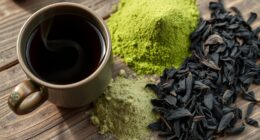Get ready to awaken your senses with a vibrant and invigorating cup of lemon, turmeric ginger tea! This golden elixir is not only a feast for the eyes but also a powerhouse of health benefits.
Imagine a symphony of zesty lemon, earthy turmeric, and spicy ginger dancing on your taste buds, while soothing your body and mind.
In this article, I will guide you through the simple steps to create this delightful concoction in the comfort of your own kitchen. From gathering the freshest ingredients to perfecting the steeping process, I will share practical tips and evidence-based information to ensure you achieve the perfect balance of flavors and maximize the numerous health benefits.
So, put on your apron and let’s embark on this aromatic journey together.
Get ready to savor the warmth and goodness of lemon, turmeric ginger tea, and experience a refreshing burst of vitality with every sip.
Let’s get started!
Key Takeaways
- Lemon, turmeric ginger tea is a vibrant and invigorating beverage with numerous health benefits.
- The tea combines zesty lemon, earthy turmeric, and spicy ginger flavors.
- The tea should steep for 5-10 minutes to allow the flavors to develop.
- Optional ingredients like honey, cinnamon, black pepper, fresh mint leaves, and coconut milk can enhance the flavor and provide health benefits.
Gather Your Ingredients
Now it’s time for you to gather all of your ingredients for this refreshing and immune-boosting lemon, turmeric ginger tea! Choosing the best lemons and turmeric is essential to ensure a flavorful and nutritious beverage.
When selecting lemons, look for ones that are firm and heavy with a bright yellow color. Avoid any that have soft spots or are overly wrinkled.
As for turmeric, opt for fresh roots instead of powdered turmeric for a more vibrant taste. Look for roots that are firm and free of blemishes.
To enhance the flavor of your tea, consider adding a few optional ingredients. Fresh ginger can add a spicy kick and additional health benefits. Choose ginger that is firm and smooth, with a strong aroma. Honey or maple syrup can be used as natural sweeteners, or you can add a pinch of cinnamon for a warming touch.
Now that you have gathered your ingredients, it’s time to move on to the next step: preparing them for brewing.
Prepare Your Ingredients
First, gather all of your ingredients to create a soothing and invigorating beverage that’ll leave you feeling refreshed and revitalized. For this recipe, you’ll need fresh lemons, turmeric root, ginger root, honey (optional), and water. However, if you don’t have turmeric or ginger on hand, you can use alternative ingredients such as turmeric and ginger powder.
Lemons are packed with vitamin C and antioxidants, which can help boost your immune system and improve digestion. Turmeric is known for its anti-inflammatory properties and can potentially reduce the risk of chronic diseases. Ginger, on the other hand, is excellent for relieving nausea, reducing muscle pain, and improving digestion.
To prepare your ingredients, start by washing and slicing the lemons. Then, peel and grate the turmeric and ginger roots. If using powdered versions, measure out the desired amount. If you prefer a sweeter tea, you can add a teaspoon of honey to the mix.
Now that your ingredients are ready, it’s time to move on to the next step: boiling the water. This’ll help extract the flavors and beneficial compounds from the lemon, turmeric, and ginger, creating a delicious and healthful tea.
Boil the Water
Once you’ve gathered all your refreshing ingredients, it’s time to bring a pot of water to a rolling boil, filling your kitchen with the comforting sound of bubbling water. Boiling water is an essential step in tea preparation as it helps to extract the flavors and benefits from the ingredients you’ll be adding.
Benefits of boiling water for tea preparation:
- Enhances flavor: Boiling water releases the volatile compounds in the tea leaves, maximizing the flavor of your tea.
- Kills bacteria: Boiling water kills any potential harmful bacteria that may be present in the water, ensuring a safe and healthy beverage.
- Removes impurities: Boiling water helps to remove any impurities or contaminants that might be present, resulting in a cleaner and purer tea.
Different methods of boiling water for tea:
- Stovetop kettle: This traditional method allows for precise temperature control and is suitable for all types of tea.
- Electric kettle: Convenient and quick, electric kettles are efficient for boiling water and often have temperature settings for different types of tea.
- Microwave: While not ideal, the microwave can be used to boil water in a pinch. However, it may not heat the water evenly, so caution is advised.
Now that the water’s boiling, it’s time to add the ingredients and let the flavors meld together for a truly invigorating tea experience.
Add the Ingredients to the Water
As you bring the pot of boiling water to life, it’s time for you to infuse it with the invigorating blend of ingredients, allowing their flavors to dance and intertwine in a harmonious symphony of taste.
There are different ways to enhance the flavor of lemon, turmeric ginger tea, giving you the opportunity to customize it to your liking. One way to enhance the flavor is by adding a teaspoon of honey, which adds a touch of sweetness and balances out the tanginess of the lemon. Another option is to sprinkle a pinch of cinnamon, which adds a warm and comforting note to the tea. Additionally, you can experiment with adding a few fresh mint leaves or a slice of fresh ginger for an extra burst of freshness and spice.
Once you have added the desired ingredients to the water, let the tea steep for about 5-10 minutes to allow the flavors to fully develop. Remember to cover the pot to retain the heat and prevent any essential oils from evaporating.
After steeping, strain the tea to remove any solids, and it’s ready to be enjoyed.
To properly store the remaining tea for later use, transfer it to an airtight container and refrigerate. This will help maintain its freshness and flavor. When you’re ready to enjoy another cup, simply reheat the tea and savor the delightful flavors once again.
Now, let the tea steep and continue the journey of creating a perfect cup of lemon, turmeric ginger tea.
Let the Tea Steep
Allow the tea to steep for 5-10 minutes, allowing the flavors to fully develop and creating a rich and aromatic infusion that will tantalize your taste buds. Did you know that the longer you steep the tea, the stronger the flavors become? Steeping time plays a crucial role in determining the taste and benefits of your lemon, turmeric ginger tea. During this waiting period, the hot water extracts the essential oils, antioxidants, and other beneficial compounds from the ingredients, infusing the tea with their goodness. It’s like a magical transformation happening inside your cup!
To help you understand the importance of steeping time, take a look at the table below:
| Steeping Time | Flavor Intensity | Benefits |
|---|---|---|
| 5 minutes | Mild | Gentle infusion of flavors and nutrients |
| 7 minutes | Medium | Balanced flavor and increased health benefits |
| 10 minutes | Strong | Robust taste and maximum extraction of beneficial compounds |
The longer you steep, the more intense the flavor and the greater the health benefits. Once the tea has steeped to your desired strength, it’s time to move on to the next step: strain and serve.
Now, let’s strain the tea and get ready to savor its delightful taste and numerous health benefits.
Strain and Serve
To strain and serve the lemon, turmeric ginger tea, I use a fine mesh strainer to remove the pieces of ginger and turmeric. This helps to ensure a smooth and enjoyable drinking experience without any bits or chunks.
Once strained, I pour the tea into cups or mugs, ready to be enjoyed. It’s important to strain and serve the tea promptly to maintain its optimal flavor and temperature.
Use a Strainer to Remove the Ginger and Turmeric
Remove the ginger and turmeric from the tea by using a strainer. Straining the tea is an essential step to ensure a smooth and enjoyable drinking experience. Here are some alternative methods of straining the tea:
-
Fine Mesh Strainer: Place a fine mesh strainer over a cup or mug and slowly pour the tea through it. The fine mesh will catch any small particles of ginger and turmeric, giving you a clear and clean tea.
-
Cheesecloth: If you don’t have a strainer, you can use a cheesecloth. Simply place the cheesecloth over a cup or mug and pour the tea through it. The cheesecloth will act as a filter, keeping any solids out of your tea.
-
Tea Infuser: Another option is to use a tea infuser. Put the ginger and turmeric in the infuser, then place it in your cup or mug. Pour the hot tea over the infuser, and it’ll strain the tea as it steeps.
Straining the tea allows you to enjoy the smooth and flavorful beverage without any unwanted debris. Now that the ginger and turmeric are removed, it’s time to pour the tea into cups or mugs.
Pour the Tea into Cups or Mugs
Once the straining is complete, simply pour the aromatic infusion into your favorite cups or mugs, ready to be savored.
Choosing the right cup or mug for your lemon, turmeric ginger tea can enhance your tea-drinking experience. There are various types to choose from, such as ceramic, glass, or stainless steel cups. Each material offers a unique aesthetic and can affect the taste of your tea.
Additionally, using a tea infuser instead of a strainer can provide added benefits. A tea infuser allows for better flavor extraction and prevents any particles from entering your cup, resulting in a smoother and more enjoyable sip.
Now that your tea is poured and ready, let’s explore the exciting world of optional additions and variations to make your lemon, turmeric ginger tea even more delightful.
Optional Additions and Variations
Enhance your lemon, turmeric ginger tea with optional additions and variations to create a truly unique and personalized flavor experience. By adding different ingredients, you can not only elevate the taste but also enjoy additional health benefits.
Here are some suggestions to try:
-
Honey: Add a touch of sweetness to balance the tanginess of lemon and the earthiness of turmeric. Honey also provides its own set of health benefits, such as soothing a sore throat and boosting the immune system.
-
Cinnamon: Sprinkle a pinch of cinnamon for a warm and comforting flavor. Cinnamon is known for its anti-inflammatory properties and can help regulate blood sugar levels.
-
Black pepper: A small amount of black pepper can enhance the absorption of curcumin, the active compound in turmeric, making it more effective.
-
Fresh mint leaves: Add a refreshing twist to your tea by throwing in a few fresh mint leaves. Mint aids in digestion and can provide a cooling sensation.
-
Coconut milk: For a creamy and tropical twist, swap regular milk with coconut milk. Not only does it add richness to the tea, but it also provides healthy fats that can help improve brain function.
Experimenting with these optional additions and variations will not only make your lemon, turmeric ginger tea more enjoyable but also offer a range of health benefits. So go ahead, get creative, and customize your tea to suit your taste and needs.
Frequently Asked Questions
Can I use powdered turmeric instead of fresh turmeric in the tea?
Yes, you can use powdered turmeric instead of fresh turmeric in the tea. However, it’s important to note that fresh turmeric has more beneficial compounds and antioxidants compared to powdered turmeric.
How long should I let the tea steep for?
Let the tea steep for about 5-10 minutes to extract the flavors and beneficial compounds. Steeping time may vary for different herbal teas, so it’s best to follow specific instructions. Adding lemon to tea can enhance the flavor and provide additional vitamin C.
Can I use honey as a sweetener instead of maple syrup?
Yes, you can definitely use honey as a sweetener instead of maple syrup in your tea. Honey has numerous health benefits, such as its antioxidant and antibacterial properties, making it a great choice for sweetening your tea.
Can I add other herbs or spices to the tea for additional flavor?
Yes, you can enhance the flavor of lemon, turmeric ginger tea by adding various herbs and spices. Experiment with different types of tea leaves and explore the health benefits of incorporating herbs and spices into your tea.
Can I refrigerate the tea and consume it cold?
Yes, you can refrigerate the tea and consume it cold. Cold tea can be refreshing and offers the same health benefits as hot tea. It can help with hydration, digestion, and provide antioxidants for overall well-being.
Conclusion
So there you have it, a simple and refreshing recipe for lemon, turmeric ginger tea. By gathering and preparing your ingredients, boiling the water, and adding the ingredients to steep, you can easily make this healthy and delicious beverage.
Don’t forget to strain and serve it hot for the best flavor. Feel free to get creative with optional additions and variations to suit your taste.
Now, who’s ready to enjoy a warm cup of this delightful tea?










